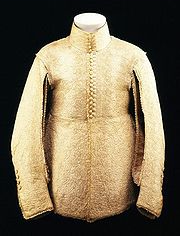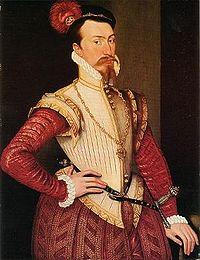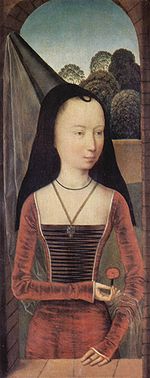Introduction
The renaissance period was a time when the fashion of both men and women in Europe underwent a radical change with the discarding of some parts of the medieval style of clothing and the invention of completely new pieces of cloth. Much like today, fashion in the renaissance period was used to define the social status of the wearer; and some fashion accessories were used to identify the position of the person in the hierarchy in the society. People in this period (as do people today) spent vast amount of money buying elaborate clothes that would accurately reflect their social status at the time.
The craftsmanship of the clothing became more elaborate; additionally, there was a preference for more expensive fabrics such as silk and cotton that were mainly imported from Asia.
The ruling class in many European countries generally determined the trends of fashion during this period; this is mainly due to the fact that only they could afford some of the new fads invented as the days went by. However, this class also attempted to control how much the lower classes could express themselves in form of fashion; this was through the enactment of laws requiring that ‘commoners’ wear clothing of one color only. This did not go down well with this class resulting in the invention of another renaissance fashion of slashing. This involved wearing two layers of clothes of different colors then making a thin slash on the outer garment so that the color of the inner garment can be seen ever so slightly. This eventually evolved to a situation where the inner garment was pulled all the way out through the slit.
Some of the more prominent fashion accessories during this period are discussed below.
Ruffs

This refers to a band worn around the neck by both men and women during this period. This accessory was usually made of lace or linen; while the original ruffs were modest in dimension, with the invention of starch the size became bigger in terms of both width and height; and the resultant garment was pleated and radiating.
The ruff was worn in Europe between the sixteenth and the seventeenth centuries; from their original sizes, ruffs became bigger aided by the strengthening ability of starch that made sure that they remained rigid around the neck; with the increase of size, some even required support by wires so as to retain their desirable shape.
The popularly of the ruffs began to wane at the close of the sixteenth century; however, before this it was a fashion accessory for the cream of the society at the time; even that of the queen such as Queen Elizabeth.
Doublet

Like many other pieces of cloth in the renaissance fashion period, the doublet started out as a practical piece of cloth with no special emphasis or distinction with any other that might have been worn in the same manner. The doublet is a close fitting jacket worn by men and had buttons on the front part.
The doublet was worn from the middle ages in Europe especially in the highlands where its design served the purpose of preventing bruising and chaffing from other courser clothing worn on the outside. However, by the close of the fifteenth century, the doublet had attained an identity of its own.
While the basic shape was retained over the years, the separation between the garment worn by everyone and the fashionable doublet was made by elaborate decorations and embroidery carried out for the owner who could afford it. The rise of the doublet as a fashion accessory was however permanently stemmed in the middle of the seventeenth century when Louis XIV and Charles II, the kings of France and England respectively created a new fashion for men which is the predecessor to the modern suit; this consisted of a relatively longer coat, a waistcoat, a cravat, a wig and breeches.
Jerkin

Worn together with the doublet, this piece of garment survived the fate of its companion in regards to disuse as it found a place in the wardrobe of the military as a practical standard issue item. The jerkin, a male garment was a close-fitting jacket, without sleeves and usually made from light colored leather.
The peak of the jerkin as a fashion accessory was in the sixteenth and the seventeenth centuries; during these periods, the jerkin was created in a manner that reflected the affluence of the wearer; with the lower classes wearing less elaborate garments in terms of decoration that their wealthier counterparts. Additionally, the general shape of the garment was modified from time to time to shapes that complemented the men fashion at the time.
In the eighteenth and nineteenth centuries, the wide use of the jerkin somewhat declined; it was not until the twentieth century during the first world war that British soldiers were issued with brown leather jerkins which were lined with wool; these garments had the double benefit of giving the soldier both agility and keeping him warm; the former function could not be afforded by the greatcoats issues to the other armies. The jerkin was used in a similar manner in the Second World War.
Hennin

This is a headdress worn by women in Europe. The center of this fashion accessory seems to be France and Burgundy; however, other parts of Europe also experienced the same phenomenon. The peak period of the hennin was in the fifteenth century.
Contrary to other fashion accessories that were developed out of practical day to day clothing, the hennin was developed as an aristocratic accessory during the middle of the century. The gear consisted mainly of a conical hat ranging between twelve to eighteen inches in length from base to pointed end. While the original hennins were all conical, later there appeared those that had a truncated end resulting in a flat top.
More often than not, the hennin was accompanied by a veil; this was attached to the top of the hat. The veil could then either flow down the shoulders extending even up to the ground; or was positioned in the opposite direction so as to cover the face of the woman. The common position of the hat was where it was tilted at an angle toward the back part of the head. A lappet made out of fabric that extended from the front part of the hat commonly covered the upper parts of the face; and sometimes was long enough to fall downward towards the shoulders. Additionally, there usually were straps attached to fasten the hat preventing it from being blown off by the wind.
Another fashion practice associated with the hennin was plucking of hair from the neck and the brow hairline so as no hair would be visible when the hat was worn. The remaining hair was tied tightly inside the hat and completely hidden.
Various artists have depicted aristocratic women wearing hennins; while the general style of wearing it is generally accepted, there are variations in shape with some being more elaborate that others. Commonly, hennins were made from a light material such as card or by making a wire frame then mounting a thin fabric on it. The aristocratic hennins were made out of rich fabrics and materials; from the basic conical shape, hennin had a variety of shapes including the truncated (flower pot), heart shaped, and beehive shaped hennins.
Others were divided into two potions on the left and right side. While the shape of the hennin is pretty simple, as with other accessories, the complexity of construction was able to effectively portray the social status of the wearer; additionally, the hennin could be decorated with jewels to give it a more exclusive and expensive look. Some of these are depicted in various portraits of royal aristocratic women during the period (Arnold, 1986; 1988).
The Trends in the Renaissance Period
The Burgundian had an immense influence in the fashion of the renaissance; this stemmed mostly from the head start that it could afford since it was not bogged down by the effects of the Hundred Years War that France and England were engaged in at the time; and thereafter the War of Roses which occupied the latter in a large remaining part of the century.
The relative peace and prosperity enabled the duchy of burgundy influence the trends of aristocratic and royal clothing; this was augmented by the access of rich fabrics from Italy and Asia; and importation of wool from England. The ruling class delved freely into the public coffers to fund these purchases of both fabrics and finished garments.
The defeat of the Duchy of Burgundy by Swiss Soldiers in the Battle of Grandson and the plundering of the fashion centers in 1476 was a major turning point in the fashion history of Europe. After successive unstable governments, Charles VIII of France eventually invaded Italy and went ahead to rule the occupied period for a while. This had the effect of introducing the dynamics of renaissance fashion to France and England; which went ahead to become centers of fashion development from the dawn of the sixteenth century (Payne, 1965).
Conclusion
The renaissance period marked the beginning of many aspects that continue to influence our lives today; no doubt, some of the fashionable garments and accessories evolved to much of the conventional clothes we wear today.
Work Cited
Arnold J: Queen Elizabeth’s Wardrobe Unlocked, W S Maney and Son Ltd, Leeds 1988. (ISBN 0-901286-20-6).
Arnold J: Patterns of Fashion: the cut and construction of clothes for men and women 1560-1620, Macmillan 1985. Revised edition 1986. (ISBN 0-89676-083-9).
Ashelford, Jane: The Art of Dress: Clothing and Society 1500-1914, Abrams, 1996.
Chappell, Mike. British Infantry Equipments 1908-1980 Men at Arms series, Osprey Publishing Ltd., London, UK.
Fernand Braudel, Civilization and Capitalism, 15th-18th Centuries, Vol 1: The Structures of Everyday Life, p. 317, William Collins & Sons, London 1981.
Kohler, Carl: A History of Costume, Dover Publications reprint, 1963, ISBN 0-486-21030-8.
Payne, Blanche: History of Costume from the Ancient Egyptians to the Twentieth Century, Harper & Row, 1965. No ISBN for this edition; ASIN B0006BMNFS.
Sherrill, Tawny: Fleas, Furs, and Fashions: Zibellini as Luxury Accessories of the Renaissance. in Robin Netherton and Gale R. Owen-Crocker, editors, Medieval Clothing and Textiles, Volume 2, p. 121-150.
Tortora, Phyllis and Keith Eubank. Survey of Historic Costume, 2nd Edition. Fairchild Publications, 1994. ISBN 1563670038.